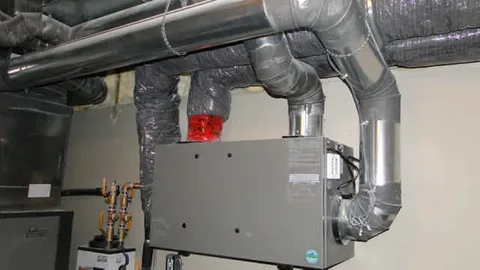Enhancing energy efficiency in any building requires smart solutions that optimize energy use. One such solution is installing a heat-recovery unit, which captures and reuses thermal energy from outgoing air to warm incoming fresh air. This innovative technology can significantly lower energy costs and improve indoor air quality. In this guide, we’ll explore the benefits of a heat recovery unit, its installation process, and how it can contribute to a more sustainable and comfortable environment.
How Heat-Recovery Units Work
Heat-recovery units operate on a simple yet effective principle: they transfer heat from outgoing stale air to incoming fresh air. This process occurs through a heat exchanger, where two air streams pass close to each other without mixing. As the warm indoor air exits your space, it warms up the cooler incoming outdoor air. The magic lies in maintaining energy efficiency while improving ventilation.
By pre-heating or cooling the incoming air based on the temperature of the outgoing air, these systems reduce reliance on traditional heating and cooling methods. This results in warmer spaces during winter and cooler interiors when summer rolls around. The heat-recovery ventilation system continuously balances airflow, ensuring optimal comfort year-round without wasting precious energy resources.
Benefits of Installing a Heat-Recovery Unit
Installing a heat-recovery unit can significantly enhance your home’s energy efficiency. These systems capture and reuse heat that would otherwise escape, reducing the demand for additional heating. This translates to lower energy costs throughout the year. Another notable benefit is improved comfort. By maintaining a consistent temperature, these units help prevent cold drafts and hot spots in your living spaces.
You’ll enjoy a cozy environment while minimizing energy waste. Moreover, using a heat-recovery ventilation system contributes positively to indoor air quality. These units exchange stale indoor air with fresh outdoor air without losing valuable warmth. As a result, you breathe cleaner air while keeping your home comfortable and efficient.
Features of Heat Recovery Ventilation Unit
Heat-recovery ventilation units offer a range of innovative features designed to enhance your home’s energy efficiency. One standout characteristic is their dual-stream design, which allows for the simultaneous exchange of stale indoor air with fresh outdoor air. This process minimizes heat loss while ensuring optimal airflow throughout your living spaces.
Another notable feature of heat recovery ventilation unit is the integrated heat exchanger, which transfers warmth from outgoing air to incoming air during colder months. This helps maintain a comfortable temperature without overworking your heating system. Some models can cool incoming air during warmer seasons by absorbing excess heat, providing year-round benefits.
Most modern units have advanced filters that improve indoor air quality by capturing dust and allergens. Many systems also include humidity control functions, allowing you to manage moisture levels effectively and prevent mould growth in damp environments.
Energy Efficiency and Cost Savings with Heat-Recovery Units
Heat-recovery units are a game changer when it comes to energy efficiency. These systems dramatically reduce the energy needed for heating and cooling by capturing and reusing heat that would otherwise be lost. This means your home stays comfortable year-round without breaking the bank.
Over time, homeowners can see significant reductions in utility bills. The initial investment in a heat-recovery ventilation unit often pays off quickly through lowered energy costs. Many local governments offer incentives or rebates for installing such eco-friendly technologies.
Not only do you save money, but you also contribute to environmental sustainability. Utilizing less energy reduces your carbon footprint while promoting greener living practices—a win-win situation for your wallet and the planet.
Types of Heat-Recovery Units
Heat-recovery units come in various types, each designed to suit different needs and environments. One popular option is the plate heat exchanger, which utilizes thin plates to efficiently transfer heat between incoming and outgoing air streams. This design maximizes surface area while minimizing space requirements.
Another type is the rotary heat exchanger, featuring a rotating wheel that captures heat from exhaust air before it exits the building. This unit can be particularly effective in colder climates where energy retention is crucial for indoor warmth. Enthalpy recovery ventilators are also available for those looking for more advanced solutions. These systems recover sensible (temperature) and latent (humidity) energy, making them ideal for humid regions or buildings requiring precise climate control.
Improving Indoor Air Quality with a Heat Recovery Ventilation System
Installing a heat recovery ventilation system can significantly enhance indoor air quality. These systems exchange stale, contaminated air with fresh outdoor air while recovering energy from the outgoing air. This process reduces pollutants and allergens indoors, creating a healthier living environment. By filtering incoming air, heat-recovery units help eliminate dust, pollen, and other irritants that can compromise respiratory health.
Improved ventilation also helps manage humidity levels, crucial for preventing mould growth and maintaining structural integrity. Moreover, consistent airflow prevents the buildup of harmful gases like carbon dioxide. As a result, you enjoy cleaner air and increased comfort in your home or workspace. With such benefits, investing in a heat-recovery ventilation system becomes essential for better indoor environments.
Comparing Heat-Recovery Units to Traditional Ventilation Systems
Heat-recovery units stand apart from traditional ventilation systems by capturing and reusing energy that would typically be wasted. While conventional systems often expel warm air, heat-recovery ventilation units transfer this warmth to incoming fresh air. This process helps maintain a comfortable indoor temperature and reduces the load on heating systems. Traditional systems often require more energy, leading to higher utility bills.
In contrast, heat-recovery and ventilation systems are designed for efficiency, allowing homeowners to save significantly over time. They enhance thermal comfort without compromising air quality. Moreover, while traditional setups can lead to stale indoor environments due to inadequate airflow management, heat-recovery units continually circulate fresh air while filtering pollutants. This results in healthier living spaces with fewer airborne irritants or allergens present.
Step-By-Step Guide to Installing a Heat-Recovery Unit
Installing a heat-recovery unit involves several critical steps to ensure optimal performance and efficiency. Here’s a step-by-step guide to help with the installation process:
Planning and Preparation
Begin by assessing your building’s layout and ventilation needs. Choose a suitable location for the heat-recovery unit, typically in a central, accessible area. Ensure there’s adequate space for both installation and maintenance. Gather necessary tools and materials, including the unit itself, ductwork, mounting brackets, and any other components required for installation.
Install the Ductwork
Proper ductwork is crucial for effective air transfer. Install the supply and exhaust ducts according to the manufacturer’s specifications. Ensure that the ducts are properly sealed to prevent air leaks. Connect the ducts to the heat-recovery unit, following the instructions provided.
Mount the Unit
Securely mount the heat-recovery unit in the designated location. Ensure it is level and firmly attached to avoid vibrations and movement. Follow the manufacturer’s mounting height and positioning guidelines to ensure proper operation and ease of access for future maintenance.
Electrical Connections
Connect the heat-recovery unit to the power supply. Ensure all electrical connections are made according to the local electrical codes and the manufacturer’s instructions. It’s often best to have a licensed electrician handle this step to ensure safety and compliance with regulations.
Testing and Calibration
Once installed, test the system to ensure its operating correctly. Check for leaks, proper airflow, and correct temperatures. Adjust the settings as needed to match your specific requirements. During the initial period, monitor the system regularly to ensure it’s functioning efficiently and address any issues promptly.
Maintenance Tips for Optimal Performance of Heat-Recovery Units
Regular maintenance is essential to ensure a heat-recovery unit’s optimal performance and longevity. Here are key tips for maintaining your system:
- Regular Filter Replacement: Check and replace the filters every three to six months or as the manufacturer recommends. Clean filters ensure efficient airflow and maintain indoor air quality by trapping dust, allergens, and other contaminants.
- Inspect Ductwork: Periodically inspect the ductwork for leaks, blockages, or damage. Properly sealed and clean ducts are crucial for effective heat transfer and system efficiency. Address any issues promptly to prevent reduced performance and energy loss.
- Clean the Heat Exchanger: Dust and debris can accumulate on the heat exchanger, affecting efficiency. Clean the heat exchanger annually to ensure optimal heat transfer and prevent potential issues. Follow the manufacturer’s instructions for safe cleaning procedures.
- Check and Maintain Fans: Regularly inspect and clean the fans to ensure smooth operation. Dust and debris can cause imbalance and noise, reducing the system’s efficiency. Lubricate moving parts if required, following the manufacturer’s guidelines.
- Professional Inspections: Schedule annual professional inspections to address potential issues and ensure the system operates efficiently. A technician can thoroughly check and calibrate the system and make necessary adjustments.
Adhere to these maintenance tips to enhance your heat-recovery unit’s efficiency, performance, and longevity.
Heat Recovery and Ventilation System: Maximizing Efficiency
A heat recovery and ventilation system enhances energy efficiency by reclaiming waste heat from exhaust air. This recovered energy is then used to pre-warm incoming fresh air, reducing the heating load on your HVAC system. It acts as a bridge between comfort and cost savings. Maximizing efficiency involves selecting the right unit for your space and ensuring it meets local building codes.
Proper sizing and installation are crucial; an oversized unit can lead to unnecessary energy consumption, while an undersized one might need to be more effectively managed in indoor climates. Regular maintenance also plays a vital role in optimizing performance. Clean filters and ducts ensure smooth airflow, allowing your system to operate at peak efficiency year-round. By investing time in upkeep, you’ll reap long-term benefits from your heat-recovery ventilation system.
Conclusion
In conclusion, integrating a heat-recovery unit into your home or business can significantly enhance energy efficiency and reduce operational costs. These units improve indoor comfort and air quality while minimizing energy waste by effectively capturing and reusing heat from exhausted air. Regular maintenance ensures optimal performance, helping to achieve long-term savings and environmental benefits. Embracing this technology represents a proactive step towards a more sustainable and cost-effective approach to climate control.
FAQs
What is a heat-recovery unit, and how does it work?
A heat-recovery unit is a system that captures heat from exhausted air and transfers it to incoming fresh air. This process helps maintain indoor temperatures while improving energy efficiency. The unit typically uses a heat exchanger to transfer heat between the two air streams without mixing them, ensuring that fresh air is warmed or cooled using the energy from the outgoing air.
What are the benefits of installing a heat recovery unit in a home?
Installing a heat recovery unit in a home offers several benefits, including improved indoor air quality, enhanced energy efficiency, and reduced heating and cooling costs. The system minimises energy wastage by recovering heat from exhausted air, leading to lower utility bills. Additionally, it provides a consistent supply of fresh air, helping to reduce indoor pollutants and improve overall comfort.
Can a heat-recovery unit be used in both residential and commercial buildings?
Yes, a heat-recovery unit can be used in residential and commercial buildings. In residential settings, it enhances comfort and energy efficiency. Commercial buildings help maintain optimal indoor conditions and reduce operational costs. The units can be scaled to suit different building sizes and requirements, making them versatile for various applications.
How does a heat-recovery unit contribute to energy savings?
A heat-recovery unit saves energy by capturing and reusing heat from exhausted air. This process reduces the need for additional heating or cooling, leading to lower energy consumption. By maintaining indoor temperatures more efficiently, the unit helps reduce the load on HVAC systems, which can significantly cut energy bills and extend the lifespan of heating and cooling equipment.


